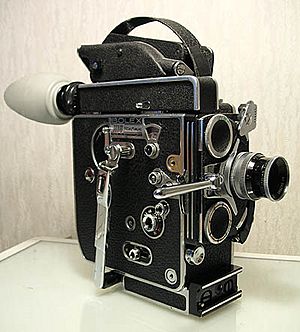Documentary facts for kids
A documentary film is a type of movie that shows real life. It's not a made-up story, but a film that aims to teach you something, share information, or keep a record of history. Long ago, documentaries were made using special film. Today, they can be made with video cameras or digital cameras. You can watch them on TV, online, or sometimes even in movie theaters. Documentaries are always changing and finding new ways to tell true stories.
Contents
What are Documentaries About?
Documentaries explore many different topics. They show us the world around us. They can help us understand people, places, and events.
Showing Real Life
The main goal of a documentary is to show reality. Filmmakers try to capture what truly happens. They don't use actors or scripts like in fiction movies. Instead, they film real people and real situations. This helps us see things as they are.
Teaching and Informing
Many documentaries are made to teach us. They can explain history, science, or how things work. For example, a documentary might show how a volcano erupts. Or it could tell the story of an important historical event. They help us learn new facts and ideas.
Sharing Important Stories
Documentaries often tell stories about important issues. They might focus on social problems or the lives of interesting people. These films can make us think deeply. They can also inspire us to make a difference. They give a voice to people and topics that might not always be heard.
How Documentaries are Made
Making a documentary takes a lot of work. Filmmakers follow several steps. They research, film, and then edit everything together.
Getting Ready to Film
Before filming, documentary makers do a lot of research. They learn all about their topic. They decide who they want to interview and what places they need to film. This planning helps them tell a clear and interesting story.
Filming and Interviewing
During filming, they use cameras and sound equipment. They might interview experts or people involved in the story. They also capture everyday moments. This footage becomes the building blocks of the film. Every shot and sound is chosen carefully.
Putting it All Together
After filming, the real magic happens in editing. Editors sort through hours of footage. They choose the best clips and put them in order. They add music, narration, and graphics. This process shapes the raw footage into a finished story.
Different Kinds of Documentaries
Just like there are different types of stories, there are different styles of documentaries. Each style tries to connect with the audience in a unique way.
Observational Documentaries
These documentaries are like being a "fly on the wall." The filmmaker tries not to interfere. They just observe and record what happens. It feels like you are right there watching events unfold naturally.
Explanatory Documentaries
This style often uses a narrator to explain facts. It might include interviews and historical footage. These films are great for teaching about complex topics. They present information clearly and directly.
Participatory Documentaries
In this type, the filmmaker becomes part of the story. They might ask questions on camera or even appear in the film. This can make the documentary feel more personal. It shows the filmmaker's journey of discovery.
Poetic Documentaries
Poetic documentaries focus more on feelings and mood. They might use beautiful images and sounds. They don't always tell a clear story with a beginning and end. Instead, they create an experience for the viewer.
Why Documentaries Matter
Documentaries are more than just movies. They play an important role in our world.
Understanding the World
Documentaries help us understand different cultures and ways of life. They can show us places we've never seen. They introduce us to people with different experiences. This helps us learn about the wider world.
Learning About History
Many documentaries preserve history. They show us what life was like in the past. They can bring historical events to life. This helps us remember and learn from what happened before.
Inspiring Change
Some documentaries highlight problems in society. They can make people aware of issues like climate change or poverty. By showing these realities, they can inspire viewers to take action. They can be a powerful tool for change.
Images for kids
-
The cover of Bolesław Matuszewski's 1898 book Une nouvelle source de l'histoire. (A New Source of History), the first publication about documentary function of cinematography.
-
Nanook of the North poster.
-
Conference of "World Union of documentary films" in 1948 Warsaw featured famous directors of the era: Basil Wright (on the left), Elmar Klos, Joris Ivens (2nd from the right), and Jerzy Toeplitz.
-
Lennart Meri (1929–2006), the second President of the Republic of Estonia, directed documentaries several years before his presidency. His film The Winds of the Milky Way won a silver medal at the New York Film Festival in 1977.
See also
 In Spanish: Documental para niños
In Spanish: Documental para niños







